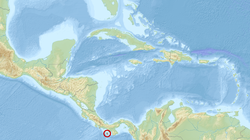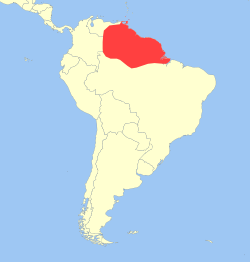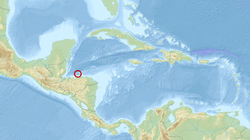| Common name | Scientific name and subspecies | Range | Size and ecology | IUCN status and estimated population |
|---|
| Azara's agouti  | D. azarae
Lichtenstein, 1823 | Central and southeastern South America
 | Size: 43–57 cm (17–22 in) long, plus 1–4 cm (0.4–1.6 in) tail [3]
Habitat: Forest [4]
Diet: Fruit, vegetables, and succulent plants [5] | DD
Unknown  [4] [4]
|
|---|
| Black agouti  | D. fuliginosa
Wagler, 1832
- D. f. candelensis
- D. f. fuliginosa
| Northwestern South America | Size: 54–76 cm (21–30 in) long, plus 2–4 cm (1–2 in) tail [6]
Habitat: Forest [7]
Diet: Fruit, vegetables, and succulent plants [5] | LC
Unknown  [7] [7]
|
|---|
| Black-rumped agouti  | D. prymnolopha
Wagler, 1831 | Eastern Brazil
 | Size: 45–52 cm (18–20 in) long, plus 1–3 cm (0.4–1.2 in) tail [6]
Habitat: Forest and savanna [8]
Diet: Fruit, vegetables, and succulent plants [5] | LC
Unknown  [8] [8]
|
|---|
| Brown agouti  | D. variegata
Tschudi, 1845 | Western South America
 | Size: 44–54 cm (17–21 in) long, plus 1–4 cm (0.4–1.6 in) tail [6]
Habitat: Forest [9]
Diet: Fruit, vegetables, and succulent plants [5] | DD
Unknown  [9] [9]
|
|---|
| Central American agouti  | D. punctata
Gray, 1842
- D. p. bellula
- D. p. boliviae
- D. p. callida
- D. p. chiapensis
- D. p. chocoensis
- D. p. columbiana
- D. p. dariensis
- D. p. isthmica
- D. p. nuchalis
- D. p. pallidiventris
- D. p. pandora
- D. p. punctata
- D. p. richmondi
- D. p. underwoodi
- D. p. urucuma
- D. p. yucatanica
- D. p. yungarum
- D. p. zamorae
| Southeastern Mexico, Central America, and northwestern South America
 | Size: 48–60 cm (19–24 in) long, plus 2–6 cm (1–2 in) tail [6]
Habitat: Forest [10]
Diet: Fruit, seeds, vegetables, and succulent plants, as well as crabs [5] | LC
Unknown  [10] [10]
|
|---|
| Coiban agouti  | D. coibae
Thomas, 1902 | Island of Coiba in Panama
 | Size: 43–45 cm (17–18 in) long, plus 3–4 cm (1–2 in) tail [6]
Habitat: Forest [11]
Diet: Fruit, vegetables, and succulent plants [5] | NT
Unknown  [11] [11]
|
|---|
| Iack's red-rumped agouti  | D. iacki
Feijó & Langguth, 2013 | Eastern Brazil
 | Size: 44–50 cm (17–20 in) long, plus tail [6]
Habitat: Forest [12]
Diet: Fruit, vegetables, and succulent plants [5] | DD
Unknown  [12] [12]
|
|---|
| Kalinowski's agouti
| D. kalinowskii
Thomas, 1897 | Southern Peru | Size: About 63 cm (25 in) long, plus about 2 cm (1 in) tail [6]
Habitat: Forest [13]
Diet: Fruit, vegetables, and succulent plants [5] | DD
Unknown  [13] [13]
|
|---|
| Mexican agouti  | D. mexicana
Saussure, 1860 | Southern Mexico and Cuba (introduced)
 | Size: 44–56 cm (17–22 in) long, plus 2–3 cm (1 in) tail [6]
Habitat: Forest [14]
Diet: Fruit, vegetables, and succulent plants [5] | CR
Unknown  [14] [14]
|
|---|
| Orange agouti
| D. croconota
Wagler, 1831 | Northern Brazil | Size: 46–56 cm (18–22 in) long, plus 1–3 cm (0.4–1.2 in) tail [6]
Habitat: Forest [15]
Diet: Fruit, vegetables, and succulent plants [5] | DD
Unknown  [15] [15]
|
|---|
| Orinoco agouti
| D. guamara
Ojasti, 1972 | Eastern Venezuela | Size: 47–56 cm (19–22 in) long, plus 2–3 cm (1 in) tail [6]
Habitat: Forest [16]
Diet: Fruit, vegetables, and succulent plants [5] | NT
Unknown  [16] [16]
|
|---|
| Red-rumped agouti  | D. leporina
(Linnaeus, 1758)
- D. l. albida
- D. l. cayana
- D. l. croconota
- D. l. fulvus
- D. l. leporina
- D. l. lunaris
- D. l. maraxica
- D. l. noblei
| Northern South America
 | Size: 47–65 cm (19–26 in) long, plus 1–3 cm (0.4–1.2 in) tail [6]
Habitat: Forest [17]
Diet: Fruit, vegetables, and succulent plants [5] | LC
Unknown  [17] [17]
|
|---|
| Ruatan Island agouti  | D. ruatanica
Thomas, 1901 | Island of Roatán in Honduras
 | Size: About 43 cm (17 in) long, plus tail [6]
Habitat: Forest [18]
Diet: Fruit, vegetables, and succulent plants [5] | EN
Unknown  [18] [18]
|
|---|























